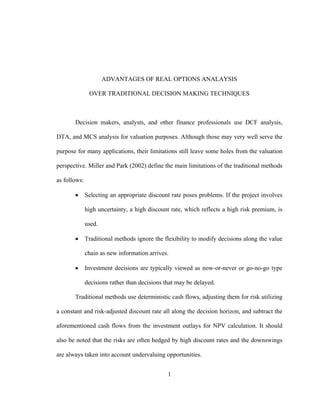
Roa
- 1. ADVANTAGES OF REAL OPTIONS ANALAYSIS OVER TRADITIONAL DECISION MAKING TECHNIQUES Decision makers, analysts, and other finance professionals use DCF analysis, DTA, and MCS analysis for valuation purposes. Although those may very well serve the purpose for many applications, their limitations still leave some holes from the valuation perspective. Miller and Park (2002) define the main limitations of the traditional methods as follows: • Selecting an appropriate discount rate poses problems. If the project involves high uncertainty, a high discount rate, which reflects a high risk premium, is used. • Traditional methods ignore the flexibility to modify decisions along the value chain as new information arrives. • Investment decisions are typically viewed as now-or-never or go-no-go type decisions rather than decisions that may be delayed. Traditional methods use deterministic cash flows, adjusting them for risk utilizing a constant and risk-adjusted discount rate all along the decision horizon, and subtract the aforementioned cash flows from the investment outlays for NPV calculation. It should also be noted that the risks are often hedged by high discount rates and the downswings are always taken into account undervaluing opportunities. 1
- 2. ROA, on the other hand, captures the upside potential only by not exercising the option when the circumstances are unfavorable. ROA only needs the risk-free interest rate since the risk can be perfectly hedged, and thus there is no need for discount rate adjustment. In other words, the risk behavior of the decision maker, thus his or her utility function is not required. Hence it is possible to eliminate subjectivity from the valuation process. Traditional methods are unrealistically deterministic, whereas ROA accounts for managerial flexibility, which is about understanding and managing the risk, as well as capturing the embedded opportunities or switching between multiple options in a financial decision problem as new information arrives and resolves uncertainty. Thus, instead of steering away from uncertainty, decision makers, analysts, and other finance professionals treat uncertainty as a profit opportunity since ROA enables them to make intelligent decisions through uncertain market circumstances. In addition to uncertainty, the length of the decision horizon increases the value of the real options, as well. However, traditional methods often consider that the long decision horizons have negative impact on NPV due to increasing uncertainty over time. Kodukula and Papudesu (2006) argue that ROA accounts for the whole range of uncertainty using stochastic processes and calculates a quot;compositequot; options value for a project, considering only those outcomes that are favorable (i.e., options are exercised) and ignoring those that are not by letting the options expire. Future cash flows that can be generated by uncertain opportunities are often ignored through valuation since traditional methods unrealistically require perfect certainty to evaluate projects. ROA, however, is capable of evaluating projects with 2
- 3. uncertain payoffs that may occur at uncertain points in time. ROA is more valuable when embedded options are about delaying, abandoning, and expanding commitments before making a final decision. Hence, riskier projects become more favorable under uncertain circumstances especially when they are market-driven. In other words, as new information arrives and the uncertainty resolves, wait-and-see approach boils down all possible outcomes into a single scenario, where decision maker may switch to a more favorable alternative instead of following an irreversible and predetermined decision path that may end up with a financial loss. The value of ROA is illustrated with a simple numerical example below. Suppose that you have a choice between investing $1M in a project today expecting to yield either $1.6M or $0.8M with 50 percent probability each and delaying that investment by one year, where the payoff uncertainty clears. The discount rate is given as 10 percent. Using traditional DCF method, the NPV for the first choice is: $ 1 .2 M NPV = − $1M = $0.0909 M (1 + 0.10 )1 On the other hand, since the uncertainty is expected to clear in one year, the investment will be made only if the outcome is favorable, which is $1.6M with 50 percent probability. Thus, the expected NPV for the delayed investment is calculated as follows: $1.6 M ⎤ ⎡ − $1M = $0.207 M NPV = 0.5⎢ + (1 + 0.10) (1 + 0.10)2 ⎥ 1 ⎦ ⎣ The value of delaying the decision is the difference between the two NPV's calculated above: $0.207M-$0.0909M = $0.1161M. 3
- 4. Also suppose that the uncertainty is increased. Thus the same project is now expected to yield either $1.9M or $0.3M with 50 percent probability each and delaying that investment by one year, where the payoff uncertainty clears. The discount rate is given as 10 percent. Then the expected NPV for the delayed investment is calculated as follows: $1.9 M ⎤ ⎡ − $1M = $0.3306M NPV = 0.5⎢ + 2⎥ ⎣ (1 + 0.10) (1 + 0.10) ⎦ 1 The value of delaying the decision when the uncertainty is increased is calculated as: $0.3306M-$0.0909M = $0.2397M. The value of the option is increased by $0.1236M demonstrating that the ROA generates more favorable results under uncertainty. References: [1] KODUKULA, P., and C. PAPUDESU, Project Valuation Using Real Options, J. Ross Publishing, Inc., Florida, 2006. [2] MILLER, L., and C.S. PARK, quot;Decision Making Under Uncertainty – Real Options to the Rescue?,quot; The Engineering Economist, Vol. 47, No.2, 2002, pp. 105-150. 4
